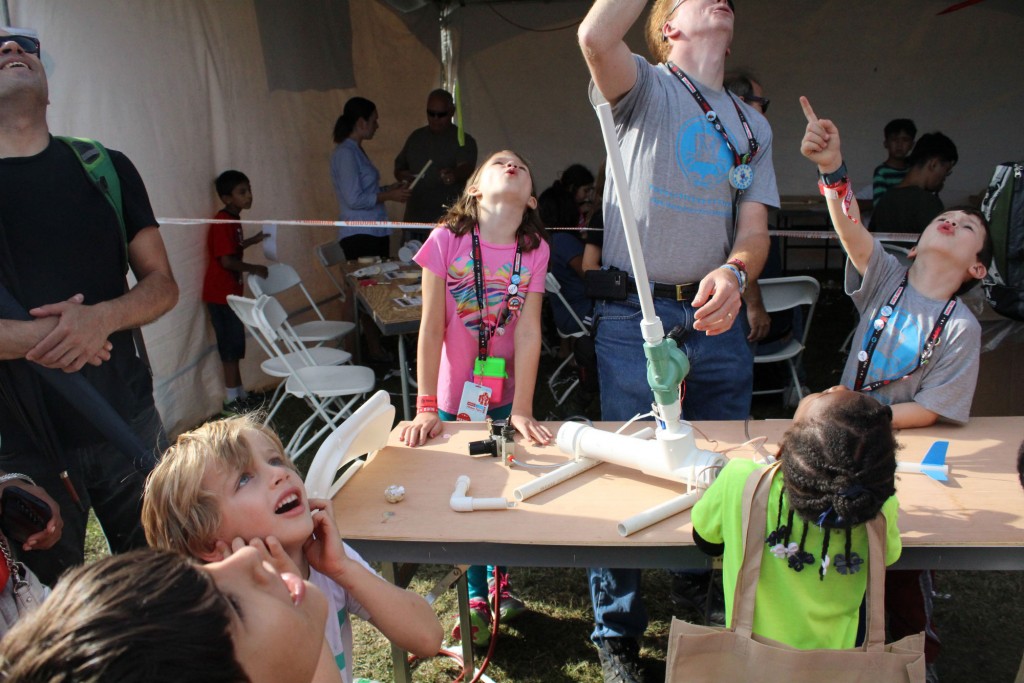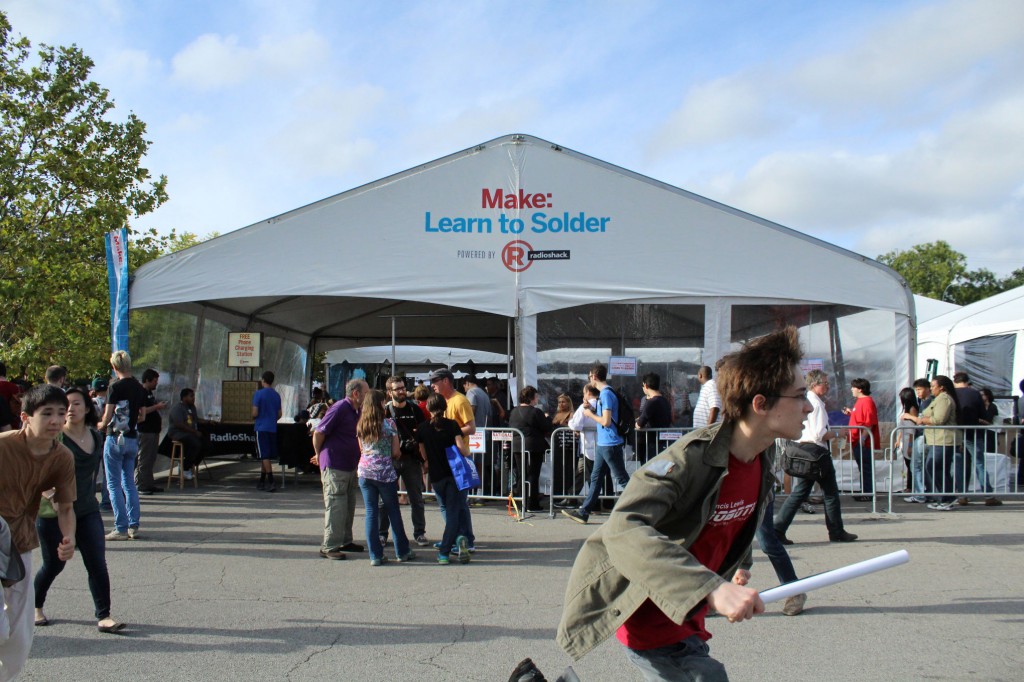
By Dan Gettinger
At the 1964 World Fair in New York City, enormous modernist pavilions displayed the latest technological creations. It was a time of great advances in science. Amidst the monuments to the achievements of the Atomic and Space Age, computers were first unveiled to the public. At Maker Faire last weekend, the same fairgrounds hosted a similar celebration of technological achievement. Maker Faire promised access to the latest open source technology and to a worldwide community of “makers.”
This year’s Maker Faire was located at the New York Hall of Science, one of the last remaining structures from the 1964 World Fair. The first Maker Faire was held in 2006 in San Mateo, California. It was conceived of by Make Magazine to “celebrate arts, crafts, engineering, science projects and the Do-It-Yourself (DIY) mindset.” The 2013 Maker Faire was loud, busy, and filled with hundreds of innovators showing off the best of what the combination of new affordable technology and human creativity can achieve.
Today there are a multitude of Faires across North America, Asia and Europe. Maker Faires are in large part geared toward a younger generation. Under a number of large tents, rows of tables were set up for kids and adults to learn how to solder circuit boards or build bottle rockets.

Maker Faire NYC was dominated by two kinds of hardware: Arduinos and 3-D printers. An Arduino, a small computer about the size of a deck of cards, is an open-source microcontroller that is easily programmable to perform automated tasks. They perform a bit like conventional computers, except that they use sensors to interact with the outside world. As a highly flexible and low cost technology, the Arduino is popular among hobbyists and artists alike. Arduinos have been used to create anything from remote-controlled lawn mowers to interactive museum exhibits.
This semester, Keith O’Hara, a professor of computer science at Bard College, is using the Arduino system in (De-)Coding the Drone, a programming class created in collaboration with the Center for the Study of the Drone. The class aims to demystify the drone as an automated machine by introducing students to programming code and algorithms. O’Hara explained that he chose to focus on the Arduino in class because of the flexibility and adaptability of the technology.
“Relying on hardware and software that is open source and supported by a strong community helps make the class accessible and relevant during our one semester experience and beyond,” O’Hara said.

Open-source software and hardware like the Arduino is at the heart of a burgeoning community of civilian drone users. In a recent Center for the Study of the Drone article, Matthew Schroyer, the founder of dronejournalism.org, described how open sourced technology is driving a revolution in civilian news gathering. At a Maker Faire in 2011, Chris Anderson, the founder of 3D Robotics and the website DIY Drones, explained why his company decided to use a customized Arduino board to create ArduPilot, an autopilot hardware that can turn any remote-controlled aircraft into a drone. “We figured that whatever problems we had, other people would solve them for us…. What we bet on with Arduino was the community,” he said in a 2011 lecture at Maker Faire in San Mateo, California.
In a 2009 blog post, Anderson proposed that the open source business model of DIY Drones should become the standard for the tech sector. He argues that the price of gadgets should reflect only the cost of manufacturing and not of intellectual property rights. In his new book, Makers: The New Industrial Revolution, Anderson takes this proposal further by writing that the manufacturing industry will be democratised thanks to new technologies such as 3-D printing and the spread of open source product designs.
When a product is open source, the blueprint of that product is freely available to the public, offering anyone the chance to contribute to its design. The idea was popularized with the development of the internet and yielded a fierce debate in the early 2000s between tech giants such as Microsoft and supporters of Red Hat, an open source software company.

Criticism of open source now gets some support from an early pioneer of virtual reality. Jaron Lanier, a writer and a computer scientist, worries that open-source will destabilize the middle class and make many jobs obsolete. In a 2006 essay titled “Digital Maoism” and in his book, You Are Not A Gadget: A Manifesto, Lanier uses Wikipedia as an example of the dangers of relying on collective intelligence as a developmental philosophy.
“No, the problem is in the way the Wikipedia has come to be regarded and used; how it’s been elevated to such importance so quickly. And that is part of the larger pattern of the appeal of a new online collectivism that is nothing less than a resurgence of the idea that the collective is all-wise,” writes Lanier in “Digital Maoism.”
Lanier takes issue with Anderson’s strategy of relying on the collective to solve the problems of the Arduino. When knowledge is shared, copied and re-copied, authorship loses meaning, lending a collectivist medium like Wikipedia a false sense of authority. Lanier predicts that when everyone begins to expect technological innovation to be freely provided, the foundation of knowledge that originally made open-sourced platforms possible will wither away.
“The digital hive is growing at the expense of individuality,” writes Lanier in You Are Not A Gadget.
Beneath the surface of Maker Faire is a raging struggle over the future of much more than software. Is it time for a new model for manufacturing? Maker Faire is a celebration of a new paradigm of technological innovation; the two aging Mercury-Atlas and Gemini-Titan rockets that stand by the New York Hall of Science seem very small compared to the technological shifts that we are seeing today. Mercury and Gemini heralded human exploration of space with all of its unknowns. Similarly, the onset of open-source technology will present a great number of new questions and possibilities.
Thanks to Professor Keith O’Hara for making this post possible.
Photos by Dan Gettinger.
